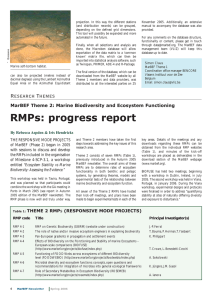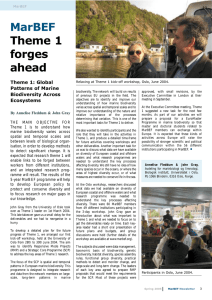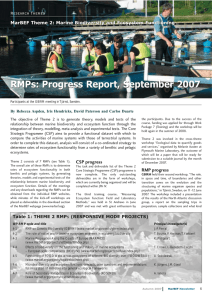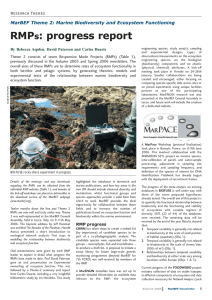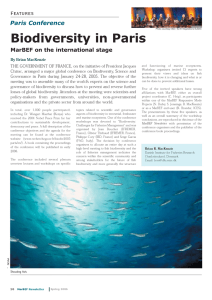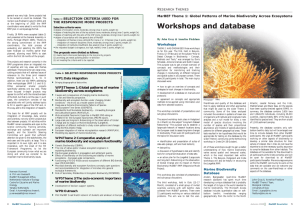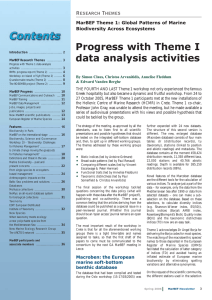A GROUP OF 44 MarBEF participants Portugal in mid-March 2005 to
advertisement
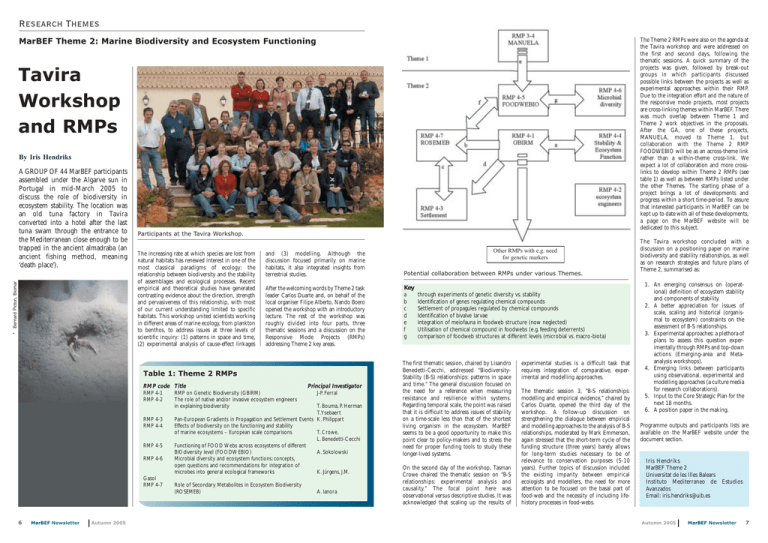
Research Themes The Theme 2 RMPs were also on the agenda at the Tavira workshop and were addressed on the first and second days, following the thematic sessions. A quick summary of the projects was given, followed by break-out groups in which participants discussed possible links between the projects as well as experimental approaches within their RMP. Due to the integration effort and the nature of the responsive mode projects, most projects are cross-linking themes within MarBEF. There was much overlap between Theme 1 and Theme 2 work objectives in the proposals. After the GA, one of these projects, MANUELA, moved to Theme 1, but collaboration with the Theme 2 RMP FOODWEBIO will be as an across-theme link rather than a within-theme cross-link. We expect a lot of collaboration and more crosslinks to develop within Theme 2 RMPs (see table 1) as well as between RMPs listed under the other Themes. The starting phase of a project brings a lot of developments and progress within a short time-period. To assure that interested participants in MarBEF can be kept up to date with all of these developments, a page on the MarBEF website will be dedicated to this subject. MarBEF Theme 2: Marine Biodiversity and Ecosystem Functioning Tavira Workshop and RMPs By Iris Hendriks ' Bernard Picton, Biomar A GROUP OF 44 MarBEF participants assembled under the Algarve sun in Portugal in mid-March 2005 to discuss the role of biodiversity in ecosystem stability. The location was an old tuna factory in Tavira converted into a hotel after the last tuna swam through the entrance to the Mediterranean close enough to be trapped in the ancient almadraba (an ancient fishing method, meaning ‘death place’). Participants at the Tavira Workshop. The increasing rate at which species are lost from natural habitats has renewed interest in one of the most classical paradigms of ecology: the relationship between biodiversity and the stability of assemblages and ecological processes. Recent empirical and theoretical studies have generated contrasting evidence about the direction, strength and pervasiveness of this relationship, with most of our current understanding limited to specific habitats. This workshop united scientists working in different areas of marine ecology, from plankton to benthos, to address issues at three levels of scientific inquiry: (1) patterns in space and time, (2) experimental analysis of cause-effect linkages and (3) modelling. Although the discussion focused primarily on marine habitats, it also integrated insights from terrestrial studies. After the welcoming words by Theme 2 task leader Carlos Duarte and, on behalf of the local organiser Filipe Alberto, Nando Boero opened the workshop with an introductory lecture. The rest of the workshop was roughly divided into four parts, three thematic sessions and a discussion on the Responsive Mode Projects (RMPs) addressing Theme 2 key areas. Table 1: Theme 2 RMPs RMP code Title RMP 4-1 RMP 4-2 RMP 4-3 RMP 4-4 RMP 4-5 RMP 4-6 Gasol RMP 4-7 6 MarBEF Newsletter Autumn 2005 RMP on Genetic Biodiversity (GBIRM) The role of native and/or invasive ecosystem engineers in explaining biodiversity Principal Investigator J-P. Ferral T. Bouma, P. Herman T.Ysebaert Pan-European Gradients in Propagation and Settlement Events K. Philippart Effects of biodiversity on the functioning and stability of marine ecosystems – European scale comparisons T. Crowe, L. Benedetti-Cecchi Functioning of FOOD Webs across ecosystems of different BIOdiversity level (FOODWEBIO) A. Sokolowski Microbial diversity and ecosystem functions: concepts, open questions and recommendations for integration of microbes into general ecological frameworks K. Jürgens, J.M. Role of Secondary Metabolites in Ecosystem Biodiversity (ROSEMEB) A. Ianora Other RMPs with e.g. need for genetic markers Potential collaboration between RMPs under various Themes. Key a b c d e f g through experiments of genetic diversity vs. stability Identification of genes regulating chemical compounds Settlement of propagules regulated by chemical compounds Identification of bivalve larvae Integration of meiofauna in foodweb structure (now neglected) Utilisation of chemical compound in foodwebs (e.g. feeding deterrents) comparison of foodweb structures at different levels (microbial vs. macro-biota) The first thematic session, chaired by Lisandro Benedetti-Cecchi, addressed “BiodiversityStability (B-S) relationships: patterns in space and time.” The general discussion focused on the need for a reference when measuring resistance and resilience within systems. Regarding temporal scale, the point was raised that it is difficult to address issues of stability on a time-scale less than that of the shortest living organism in the ecosystem. MarBEF seems to be a good opportunity to make this point clear to policy-makers and to stress the need for proper funding tools to study these longer-lived systems. On the second day of the workshop, Tasman Crowe chaired the thematic session on “B-S relationships: experimental analysis and causality.” The focal point here was observational versus descriptive studies. It was acknowledged that scaling up the results of experimental studies is a difficult task that requires integration of comparative, experimental and modelling approaches. The thematic session 3, “B-S relationships: modelling and empirical evidence,” chaired by Carlos Duarte, opened the third day of the workshop. A follow-up discussion on strengthening the dialogue between empirical and modelling approaches to the analysis of B-S relationships, moderated by Mark Emmerson, again stressed that the short-term cycle of the funding structure (three years) barely allows for long-term studies necessary to be of relevance to conservation purposes (5-10 years). Further topics of discussion included the existing imparity between empirical ecologists and modellers, the need for more attention to be focused on the basal part of food-web and the necessity of including lifehistory processes in food-webs. The Tavira workshop concluded with a discussion on a positioning paper on marine biodiversity and stability relationships, as well as on research strategies and future plans of Theme 2, summarised as: 1. An emerging consensus on (operational) definition of ecosystem stability and components of stability. 2. A better appreciation for issues of scale, scaling and historical (organismal to ecosystem) constraints on the assessment of B-S relationships. 3. Experimental approaches: a plethora of plans to assess this question experimentally through RMPs and top-down actions (Emerging-area and Metaanalysis workshops). 4. Emerging links between participants using observational, experimental and modelling approaches (a culture media for research collaborations). 5. Input to the Core Strategic Plan for the next 18 months. 6. A position paper in the making. Programme outputs and participants lists are available on the MarBEF website under the document section. Iris Hendriks MarBEF Theme 2 Universitat de les Illes Balears Instituto Mediterraneo de Estudios Avanzados Email: iris.hendriks@uib.es Autumn 2005 MarBEF Newsletter 7
